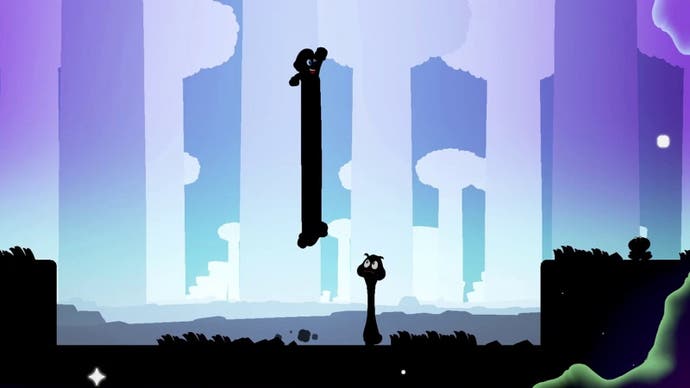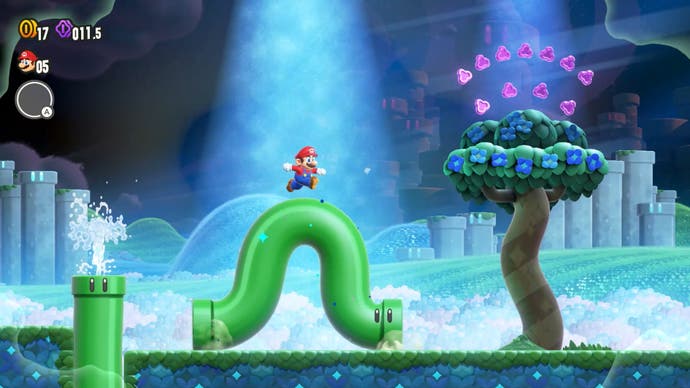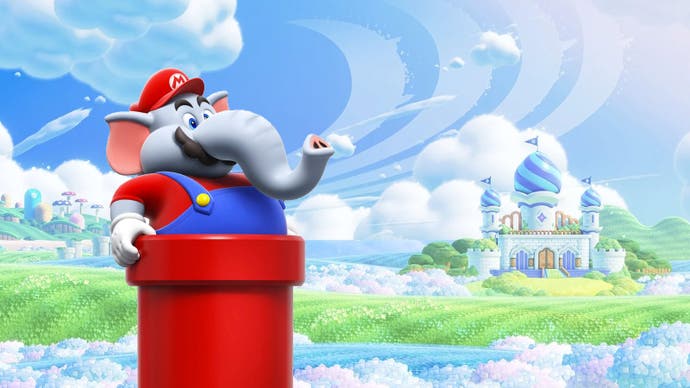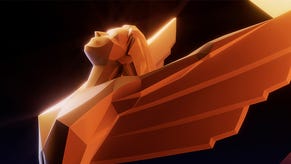Super Mario Bros. Wonder developers discuss Nintendo's push to reinvent its classic side-scrolling formula
"You need to try harder to surprise these players."
It's been 11 years since the last proper Mario side-scroller, a fact that surprises Nintendo's veteran exec Takashi Tezuka when I point it out. Tezuka has worked on dozens of projects since the launch of 2012's New Super Mario Bros. U - including Super Mario Maker, Nintendo's create-your-own-Mario sandbox. Still, such a wait for more handcrafted Mario levels seems notable.
Why so long? Speaking with Nintendo, it sounds like the company's desire to keep its classic side-scrolling formula fresh has remained paramount. There have been so many 2D Mario games now - including a whole string of releases that sought to emphasise their freshness by sticking "New Super Mario" in their title. After those - and after letting players go wild with the company's own Mario toolkit - what could Nintendo do next? Something that feels truly new again, I'm happy to report.
In Super Mario Bros. Wonder I can be a Mario who shoots bubbles, capturing enemies and errant koopa shells in upwards floating soap suds, then suddenly transform into some form of sentient goomba - though I'm still Mario with his iconic hat, of course. Waddling across platforms and dodging enemies via stealth mechanics, I pass a talking flower who loudly wonders how I'll taste. Sure, why not.
"There was a lot of feeling about creating something else, something new," Tezuka tells me, in an interview conducted after a hands-on session last week at Gamescom. "After Mario Maker I was actually asked by a lot of people about what's next - what's gonna happen next? I told them that at the time we were still thinking of a lot of new things to do. So I'm glad we now have the opportunity to show them!"
"In terms of the concept for creating a new Mario, we came up with the concept of mystery and secrets," Super Mario Bros. Wonder's director Shiro Mouri, adds. Mouri has been with Nintendo since 1997 and previously directed New Super Mario Bros. U Deluxe, after working as a programmer on various 2D Mario and Zelda titles. "The first Super Mario game was full of secrets and mystery," he continues, noting how power-ups and warp pipes - now-familiar items to any Mario fan - were once surprises.
"The challenge became that these kinds of secrets and surprises were more and more normalised."
"As we were developing more and more side-scrolling Mario games, the challenge became that these kinds of secrets and surprises were more and more normalised to players," Mouri continues. "So I thought it'd be important to create a side-scrolling Mario that really fit the day and age that we live in now.
"You need to try harder to try and surprise these players."
Well, Super Mario Bros. Wonder definitely does that. A brilliantly original take on Nintendo's classic Mario formula, the game sees Mario and friends exploring the Flower Kingdom, a new world brought to life through more expressive character animations and eye-catching backgrounds. The star of the show is, as we've already seen, Elephant Mario - a hulking version of our hero who can stomp around and hold water in his trunk, and shoot it at enemies to stun them. Of course, this is also a multiplayer Mario game - so where there's an Elephant Mario, there's also an Elephant Luigi, Peach, Daisy, Toad and Toadette. (Options to play as the Yoshi and Nabbit also exist, invulnerable to damage but without access to power-ups.)

Elephant Mario was born out of a desire to have Mario inhabit a larger form so players could easily hit blocks or get coins, Mouri says, as well as the idea of being able to spray water - which comes in handy for blooming the Flower Kingdom's plants and unlocking secrets, including something at the end of levels. "We did try to think of various ideas but the one form we thought would really satisfy all these elements was, inevitably, the elephant," he notes.
But there's far more to Wonder than Elephant Mario. For example: the Wonder element to courses, triggered by activating a Wonder Seed, an often-hidden item which brings about a sudden trippy change to gameplay. Wonder Seeds can turn parts of a level into a frantic dash against a ticking clock, or see Super Stars rain down from the sky, or inflate Mario like Violet Beauregarde, or turn him into a goomba, or call upon a stampeding herd of bulls you can ride atop as you storm over a course's traditional end flagpole and on into the distance. Or you can choose not to activate a level's Wonder Seed at all. It's up to you.
Mouri and his team began work on Super Mario Bros. Wonder by thinking about an evolution of the traditional Mario idea where you are taken somewhere else in a level, such as via a warp pipe or a vine. These embodied the mysteries and secrets Nintendo wanted to bring back to Mario to make the series more surprising for players.
"As sort of a new version of this, we thought if you got a new item, you'd go into a separate area," Mouri says. "I showed this to Mr Tezuka and his response was that if you get an item and go somewhere else, then the concept was the same as what we had until now. So the starting point of Wonder in a sense was that comment, the suggestion that maybe instead of warping somewhere else, [we should] create change in the [actual level]."

"The core of this game is really the discussions we had surrounding what a new Mario that fits this day and age is," Tezuka adds. But what makes a Mario game for this day and age? Mouri points to new choices and features in Wonder designed to give players more freedom to explore and tackle the game how they want, such as the introduction of difficulty ratings for levels visible from the World Map.
"If you think it's a bit too difficult you can leave it for later and move on to a different course," Mouri says. This is aided by the World Map now being freely explorable, a mini open-world of its own which you can roam around to uncover later levels or bonus-style stages to try instead. If you're stuck, you can take some time out with a Break Time course - a mini Mario level that feels like a brief snatch of a brilliant idea, allowed to exist as its own little gem rather than being spread out over a full course. One I played saw Mario hopping over musical notes on a keyboard to defeat enemies while unlocking a familiar tune.
"Including Daisy will help resolve fights within my own household."
Another big change to gameplay are Badges, which bestow effects on characters or levels. Badges are picked before a course begins, and can give players a higher jump or a parachute - mimicking abilities previously found on specific characters like Luigi, or past power-ups. Other Badge options allow you to tweak levels to offer more coins or rewards. At a base level, all of the game's main characters now control the same - so Mario and Luigi jump the same as Peach and Daisy - but through Badges you can have a Mario with the floaty jump of his brother. It makes for more of a level playing field when playing in multiplayer - while allowing for specific players to still get access to abilities without them being tied to playing as a particular character.
Speaking of which, Mouri notes the positive response online to Nintendo's announcement that Daisy is playable. It's a character he was pleased to include as well, he says. "This is a personal family anecdote but I have two daughters myself and when they played previous Mario titles, they would always fight over who gets to play Peach. Including Daisy will help resolve fights within my own household, and also I thought that having Daisy would be something that a lot of Mario fans would be happy with!"

Continuing the theme of player choice is the ability to now play in local or online co-op, the latter of which allows you to group up in a party of 12 players - albeit with a limit of four playing together in any particular world. But despite the upped player count, multiplayer feels a lot less stressful, with characters now moving through each other rather than bouncing on top of on another, and the ability to share items.
A stand-out enemy is the new Maw Maw creature, a giant mouth on two stubby legs that can stretch upwards to gobble anything in its path - power-ups, coins, even other enemies - and especially you. His ability to suddenly grow large is a fun trick to try and tackle, and understanding his antics is another small example of how this new enemy type keeps players on their toes. Want to jump on a Maw Maw's head to defeat it? You'll need to be able to hit it twice. Throw a shell in its face? It'll simply gobble it up. Hoping to get that power up? You better reach it first.
Maw Maws also form part of the game's stealth gameplay mentioned previously, found when activating a Wonder Seed and playing as a goomba version of your character. As a goomba, you have a hilariously puny jump (although also the ability to stand on spikes without damage) and must scuttle about levels without being seen by the hungry Maw Maw enemies. Bushes now become hiding spots, as you rush between safe zones to avoid their patrols.
Alongside Elephant Mario, Super Mario Wonder introduces two other new power-ups. Drill Mario allows you to damage enemies or hide by burrowing down into floors, an ability which also allows you to unlock new paths and collectibles by shattering quartz blocks in caves. Here, you can also use your drill skills to access hidden areas through narrow crevices. Then there's Bubble Mario, who can fire bubbles at enemies to trap them and send them skywards. There's a lot to take in, but that's the point, I think. After a decent chunk of time with the game, there's still a lot to uncover - and it sounds like this feeling of discovery is something Nintendo wants to keep going, even after you've completed a level for the first time.
"I don't want to say that there are big differences between the older players and newer players, but I think those who played the initial Super Mario games were more actively exploring the game," Tezuka notes. Some players simply play each course once and move on, he continues - whereas with Wonder, players will find reasons to revisit areas again.
"Mouri-san has included a lot of elements in the courses where, if you go back into play again, you'll find new things or a lot of added elements where it allows for the replaying of courses."
After 11 years, it feels like Nintendo's 2D Mario team is finally back - and properly so. Did Nintendo feel the pressure after seeing players' Mario Maker creations? "Personally I don't have the impression that the hurdle was raised in creating something on Nintendo's side," Tezuka tells me, saying that Wonder was very much built as an idea from scratch. Before my time with Nintendo is up, I can't help but wonder. With 2D Mario reinvigorated, is there still room for new 2D Zelda, in a world where Breath of the Wild is so successful? "I've left all of these other topics to Aonuma-san," Tezuka says. So no Super Zelda Wonder? Tezuka laughs.
And finally, a question on my personal favourite Nintendo franchise. Tezuka is a veteran of the Pikmin series, and recently served as producer on Pikmin 4. After a 10-year wait for a new game, could Nintendo try to ensure Pikmin 5 did not take as long? "I think that would be best as well," Tezuka smiled. "We'll try not to let everyone wait."











